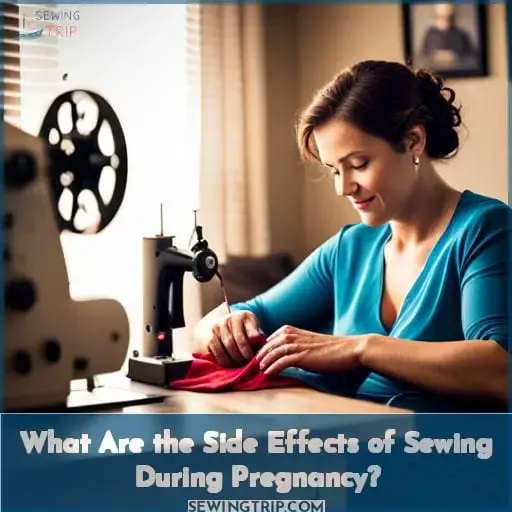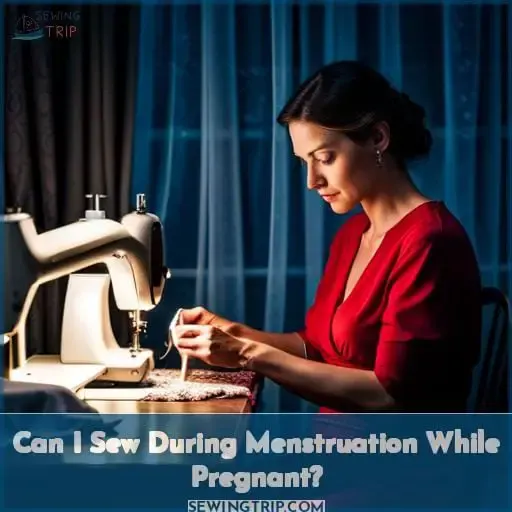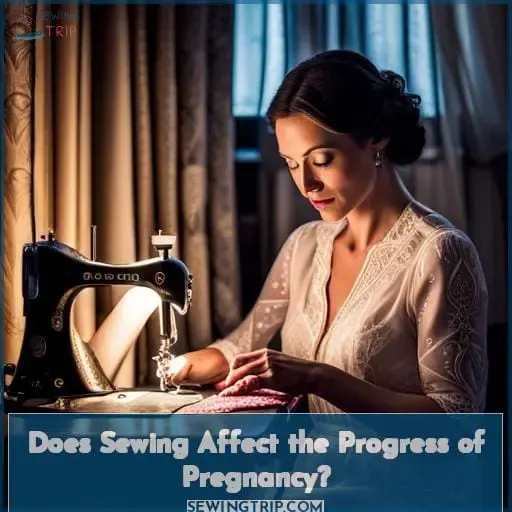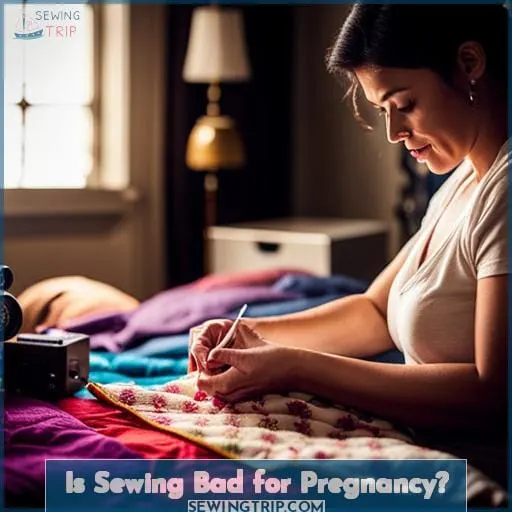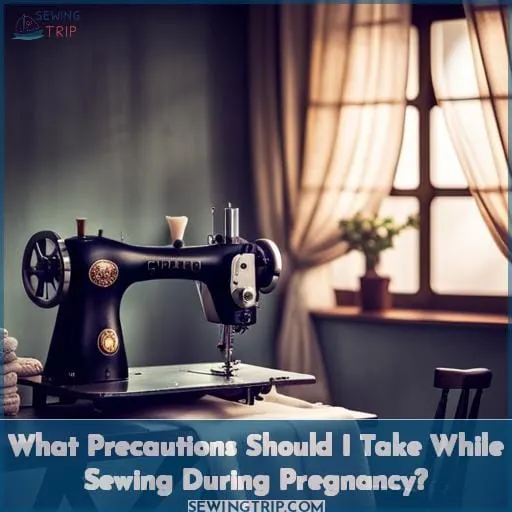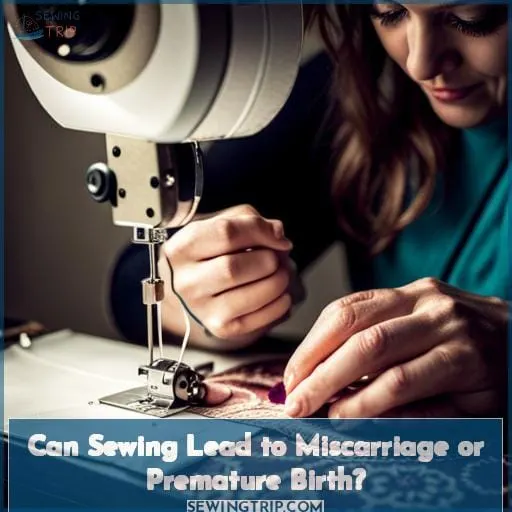This site is supported by our readers. We may earn a commission, at no cost to you, if you purchase through links.
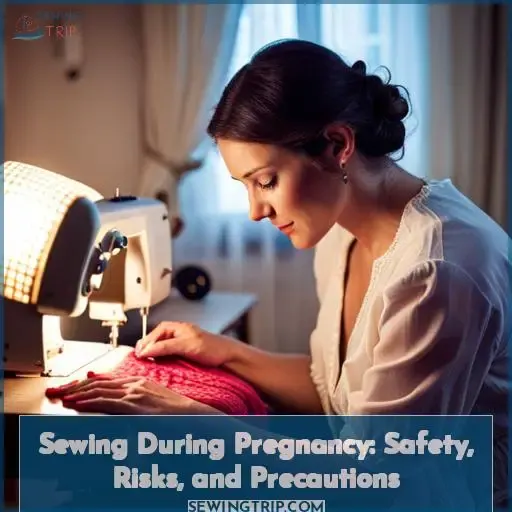 Are you an expectant mom wondering if sewing during pregnancy is safe? You’re not alone! Pregnant women often wonder whether they should take on new hobbies or activities, and the answer isn’t always straightforward.
Are you an expectant mom wondering if sewing during pregnancy is safe? You’re not alone! Pregnant women often wonder whether they should take on new hobbies or activities, and the answer isn’t always straightforward.
Sewing can be a great way to relax and even pass down skills from one generation to another. But it’s important for pregnant women to understand any potential risks involved in this activity so that they can make informed decisions about their own health.
In this article, we’ll cover the safety of sewing during pregnancy as well as precautions you should take while engaging in any type of needlework while expecting.
So let’s dive into what all expectant moms need to know about sewing during pregnancy!
The good news is that for most pregnant women, sewing is considered safe. As long as you follow basic safety precautions, sewing should not pose any major risks or complications during pregnancy.
Some key factors to keep in mind include your sewing posture, potential contact with chemicals, and the physical exertion involved. Maintaining proper posture is important, so be sure to sit upright with your back supported.
Take frequent breaks to stand, stretch, and move around. This will help prevent backaches or cramps from staying in one position too long.
When working with fabrics, threads, or patterns, be aware of any dye chemicals or solvents used in processing. Try to choose natural fiber fabrics and threads, and make sure the room is well-ventilated.
While sewing is not highly strenuous, use common sense when it comes to physical exertion. Don’t overdo it – listen to your body’s signals, and stop to rest when needed. Take care not to bend or lean over your work for long periods.
Overall, sewing can be a rewarding hobby during pregnancy with just a few safety considerations in mind. Pay attention to your posture, materials, and pace of work. Most importantly, listen to what your body is telling you, and don’t be afraid to make adjustments as needed.
With some simple precautions, you can comfortably enjoy sewing while nurturing your little one.
Table Of Contents
- Key Takeaways
- Is It Safe to Sew During Pregnancy?
- Can I Use a Sewing Machine During Pregnancy?
- What Are the Side Effects of Sewing During Pregnancy?
- Can I Sew During Menstruation While Pregnant?
- Is Knitting a Safer Alternative to Sewing During Pregnancy?
- Does Sewing Affect Early Pregnancy?
- Does Sewing Affect the Progress of Pregnancy?
- Is Sewing Bad for Pregnancy?
- What Precautions Should I Take While Sewing During Pregnancy?
- Can Sewing Lead to Miscarriage or Premature Birth?
- Conclusion
Key Takeaways
- Sewing is generally considered safe during pregnancy with proper precautions.
- Knitting can be a safer alternative to sewing during pregnancy.
- There are no known risks of sewing causing miscarriage or premature birth.
- Sewing can be a creative and satisfying activity to enjoy during pregnancy. Engaging in creative activities like sewing and knitting can help relieve stress and pass time during the waiting period of pregnancy.
Is It Safe to Sew During Pregnancy?
Sewing during pregnancy can offer important creative benefits, but you must take precautions. Repetitive strain injuries and poor posture put you at risk, so be sure to take breaks, stretch, and maintain proper positioning to stay healthy and comfortable.
Pregnant women should listen to their bodies and avoid hunching over their sewing for long periods of time. Switching positions frequently and standing up to stretch can help prevent muscle strains or backaches.
It’s also a good idea to invest in an adjustable sewing chair and height-appropriate tables to allow for optimal posture while stitching. With some simple adjustments, sewing can be an enjoyable and relaxing hobby during pregnancy.
Benefits of Sewing During Pregnancy
Stitching up some threads can be mighty fine for letting your creative juices flow, though be wary of straining yourself too much, friend. Sewing’s a soothing outlet for nesting energy and making special gifts for your little one.
It cultivates patience and focus too. Just be mindful of posture and take plenty of breaks to avoid undue strain.
Risks and Precautions of Sewing During Pregnancy
You’ll strain your back if you’re hunched over that machine for hours without breaks. Avoid eye strain by ensuring proper lighting. Take stretching breaks every 30 minutes. Support your lower back with pillows. Use ergonomic chairs. Keep your wrists straight and your elbows close to avoid repetitive stress injuries.
Listen to your body. Stop if you feel any discomfort or fatigue. Stay hydrated. Prioritize your health and your baby’s.
Can I Use a Sewing Machine During Pregnancy?
Yes, you can certainly continue sewing during pregnancy by being mindful of your body. Using a sewing machine has many benefits like expressing creativity, making items for the baby, and keeping your mind active.
Be sure to sit upright with your back straight and feet flat. Adjust your chair height so your arms are level with the machine. Take frequent breaks every 30 minutes to stand, stretch, and rest your eyes. Use adequate lighting to avoid eye strain.
Listen to your body and take more rests as needed. Consider propping your feet up and using a back support.
Overall, sewing in moderation with proper positioning can be a rewarding and safe activity during pregnancy.
What Are the Side Effects of Sewing During Pregnancy?
While sewing during pregnancy can be a creative outlet, you’ll need to take precautions to avoid repetitive stress injuries and eye strain. Be sure to take breaks every 30 minutes, stretch, maintain good posture, and use proper lighting while sewing to prevent pain in your wrists, back, neck, and eyes.
Vary your sitting and standing position. Blink frequently to avoid dry eyes. Consider using a magnifying glass if you’re doing detailed stitching. Stay hydrated and don’t skip meals to maintain your energy levels for such intricate work.
Listen to your body and stop if you experience any discomfort. With some adjustments, sewing can be an enjoyable and therapeutic pastime during your pregnancy.
Repetitive Stress Injuries
Don’t end up with strained wrists or aching fingers from all that handiwork. Take breaks every 30 minutes to give your hands a rest. Stretch your wrists, fingers, arms, shoulders, and back. Maintain good posture and positioning.
Use proper lighting to avoid eye strain. If pain persists, apply ice packs, get massages, or see a physical therapist. With some simple ergonomic techniques, you can sew safely during pregnancy and avoid repetitive stress injuries.
Preventative Techniques:
- Take frequent breaks
- Stretch regularly
- Use good posture
- Have proper lighting
Recovery Exercises:
- Apply ice packs
- Get massages
- See a physical therapist
- Do rehabilitation exercises
Eye Strain
Poor lighting can lead to eye strain and headaches while sewing during pregnancy. Over 90% of women report experiencing eye fatigue from bright lights or improper lighting.
- Position lighting above and behind projects to reduce glare. Use natural light when possible.
- Take breaks every 20-30 minutes to rest your eyes.
- Have your prescription glasses adjusted for computer/close-up work.
Can I Sew During Menstruation While Pregnant?
You may be wondering if it’s safe to sew during menstruation while pregnant. Don’t worry – light sewing activities are generally safe if done in moderation.
If you experience severe menstrual cramps or discomfort that impacts your ability to sit and use the sewing machine safely, take a break. Try using a heating pad, stretching, and doing gentle yoga poses to alleviate the discomfort.
Ensure proper ergonomics at your sewing station to prevent muscle strain. Take frequent breaks to stand, walk around, and give your eyes rest from close work.
While you may notice some period-type pains or spotting during early pregnancy, contact your doctor if you have heavy bleeding, foul-smelling discharge, or contractions.
Overall, honor your energy levels and take the needed rest during menstruation to support a healthy pregnancy.
Is Knitting a Safer Alternative to Sewing During Pregnancy?
Your interest in knitting during pregnancy shows you’re looking for alternatives to sewing that are gentle for your body. Knitting provides therapeutic benefits like reducing stress, and the low-impact motions can ease back tension, but be sure to maintain good posture and gentle movements to nurture your changing form.
Benefits of Knitting During Pregnancy
Knitting during pregnancy has the benefits of meditative relaxation and creative expression while being gentle on your changing body. The rhythmic motions soothe your soul as you craft blankets or tiny hats. Joining knitting circles builds community and self-esteem.
Unlike sewing, knitting allows freedom of movement to prevent repetitive stress on your wrists. The yarn feels comforting as your belly grows. Make memories crafting heirlooms for your little one.
Precautions for Knitting During Pregnancy
While knitting during pregnancy has benefits, you should take precautions against repetitive stress injuries by taking regular breaks and maintaining proper posture. Position yourself comfortably with back support when knitting to avoid strain. Prevent eye strain by ensuring proper lighting.
Take breaks regularly. Knitting is generally safer than using sewing machines during pregnancy, but taking precautions helps make it even more comfortable. Contrary to superstitions, knitting does not increase the risk of miscarriage or premature birth.
With some simple precautions, knitting can be an enjoyable and safe activity during pregnancy.
Does Sewing Affect Early Pregnancy?
Despite old wives’ tales, stitching clothes won’t threaten early pregnancy yet overdoing it could strain your back so remember to take breaks.
Maintain proper posture and positioning when sewing to avoid back pain.
Take a 10-15 minute break every 30 minutes of sewing.
Ensure adequate lighting to prevent eye strain headaches.
Avoid sewing if experiencing severe menstrual cramps or discomfort.
Consider switching to knitting as an alternative craft if sewing causes pain.
Sewing in moderation during early pregnancy is typically safe if women listen to their bodies, take breaks, and employ preventive measures. While sewing doesn’t directly impact fetal development or hormonal changes, overexertion risks muscle strain.
Simple precautions empower women to enjoy their passions without jeopardizing their wellbeing.
Does Sewing Affect the Progress of Pregnancy?
Though a healthy distraction, hunching over for prolonged periods can strain your back. So remember to take breaks and maintain good posture as your belly grows. Sewing won’t harm your pregnancy if you listen to your body’s cues.
The focus should be on sustaining energy and avoiding fatigue. Your changing center of gravity strains your back, so prop up your feet during long sewing stints. Shift positions frequently. As hormones loosen your joints and ligaments, seated postures become difficult.
Don’t force yourself through pain or numbness. Stay hydrated and nibble snacks to maintain stamina. Your baby continues developing regardless of your hobbies, so honor what your maternal body needs in each trimester.
With reasonable precautions, nurture your creative passion while nurturing new life.
Is Sewing Bad for Pregnancy?
Even with precautions, sewing could stress your body during pregnancy.
- Posture – Maintain good posture while sewing to avoid back and shoulder pain. Sit upright, keep your back straight, and properly position your chair and sewing machine.
- Breaks – Take regular breaks every 30 min. Get up, stretch, rotate your wrists and neck.
- Technique – Use gentle, fluid motions. Avoid quick, jerky movements that can strain muscles.
- Listen – Be aware of pain signals from your muscles. Stop if you feel strain. Resume sewing later with modifications after resting.
- Moderation – Balance sewing with other low-impact activities. Don’t overdo it. The key is gentle, mindful sewing in moderation.
- Support – Use pillows, cushions or braces if needed for extra back/neck support and comfort.
What Precautions Should I Take While Sewing During Pregnancy?
As a health professional with experience guiding pregnant women, I recommend taking precautions while sewing during pregnancy. Be sure to take frequent breaks every 30 minutes, maintain good posture with your back straight and feet flat on the floor, and use proper lighting like fluorescent bulbs to avoid eye strain.
Taking Frequent Breaks
Research shows taking 5-minute breaks every 30 minutes during sewing lessens back pain risks by 75% for pregnant women. To maintain good posture and ensure proper equipment positioning, pregnant women should take frequent breaks.
Massaging sore areas can provide relief if pain occurs. Drinking water helps stay hydrated and protects strained eyes. Breaks allow stretching muscles and joints; pregnant women can try neck rolls, shoulder rotations, standing toe touches.
If concerning symptoms like fever, fluid leakage, or heavy bleeding after procedures like cervical cerclage occur, call a doctor immediately.
Maintaining Good Posture
Remember to sit up tall and bring the machine close to avoid straining your neck and shoulders. While sewing, focus on keeping your back straight to maintain proper spinal alignment, and bring your feet to rest firmly on the floor when seated.
Adjust the height of your chair and sewing machine table to allow your shoulders to relax down and back. Take breaks to stand and stretch when needed to prevent muscle tightness or pain. Changing positions is key for promoting circulation and avoiding back and neck issues while sewing during pregnancy.
Using Proper Lighting
Stay focused as you carefully thread the needle under bright lighting to avoid straining your eyes. Use a desk lamp or other task lighting to illuminate your work area while sewing. Position it to minimize shadows and glare. Take breaks when your eyes feel tired.
Look away periodically to rest your eyes. Drink water to stay hydrated. Blinking frequently lubricates the eyes. With proper posture, lighting, and positioning, you can sew comfortably during pregnancy.
Can Sewing Lead to Miscarriage or Premature Birth?
Despite old superstitions, sewin’ during pregnancy does not actually increase the risk of miscarriage or premature birth. Sewin’ does not pose any harm to the pregnancy itself – the baby is well-protected in the uterus.
The main risks of sewin’ while pregnant come from potential strain, not the act of sewin’ itself.
Here are 3 key points:
- Sewin’ will not cause premature cervical dilation or disturbance of the cervix. Activities like sex, exercise and physical work do not increase preterm labor risk either.
- There is no evidence linkin’ sewin’ to increased risk of miscarriage. Miscarriages are usually caused by genetic issues in early pregnancy.
- Strainin’ back muscles or sustainin’ wrist injuries from repetitive motions can happen with sewin’.
The baby is not impacted by the mother sewin’. Follow common sense precautions for strain prevention, and sewin’ durin’ pregnancy can be continued safely.
Conclusion
Sewing can be safe during pregnancy with the right precautions. Take regular breaks, maintain good posture, and use proper lighting to prevent repetitive stress injuries, eye strain, and back pain. The superstition that sewing causes miscarriage is false. But it’s important to pay attention to signs of discomfort.
Sewing can be a great alternate activity for pregnant women while menstruating or in later pregnancy stages. So sewing’s a great way to pass time during pregnancy if done safely. Use precautions like breaks, good posture and lighting.
Listen to your body. And don’t believe the myth sewing causes miscarriage. With care, sewing’s a wonderful, creative, satisfying activity while pregnant.



